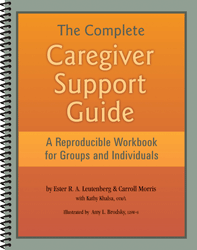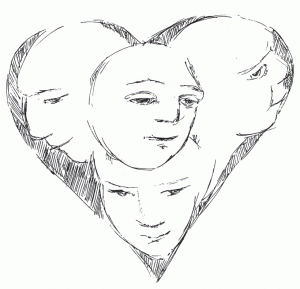About Caregivers:
 Former First Lady Rosalynn Carter stated,
Former First Lady Rosalynn Carter stated,
“There are four kinds of people in this world: those who have been caregivers, those who currently are caregivers, those who will be caregivers, and those who will need caregivers.”
This includes virtually everyone!
A Brief History of Caregiving
In past generations, it was customary for people to have large families. Members of an extended family often lived within a few miles of each other. Few women had jobs outside the home, so the elderly and infirm were cared for within the family. Both the primary caregiver and care-receiver had the support of nearby relatives, friends and community.
Circumstances are different today. Families are typically smaller and are often scattered across the country and around the globe. A much larger percentage of women work outside the home. People live longer, often with chronic illnesses. These factors make caregiving much more complicated than it was in the past.
The early stage of caregiving is often handled by family members or by friends who live near the person needing help. They begin by simply doing what they can and often, as time passes, assume the caregiver role without realizing it – caregiving isn’t a job that many people choose to sign up for.
The tasks caregivers perform can vary widely, from transporting a child with disabilities to school each day, to doing someone else’s laundry, to helping with medications, to dealing with insurance companies. Caregiving can be temporary, as when someone is recovering from an accident, or long-term, as when caring for a person in need of significant ongoing support.

Illustration by Amy L. Brodsky, LISW-S
In an attempt to define family caregiving, the National Family Caregivers Association (NFCA) developed a list called “Caregiving Is.” The text below was inspired by that list.
Caregiving is as diverse as the individuals needing it. It can be 24-hour care for persons who cannot manage daily tasks of living or are suffering a significant level of cognitive loss. It can be preparing for an uncertain future because a spouse has a progressively disabling disease, even though that person is still able to function quite well. It can be temporary, last several years or last a lifetime.
Caregiving means being a person’s healthcare advocate. It requires learning to work with doctors and other health care professionals and to navigate government healthcare programs. It can also be learning what it means\ to die with dignity and making sure that the care-receiver’s wishes will be honored.
Caregiving is stressful work. Most people have had no training or education regarding the many aspects of caregiving when they begin helping their care-receiver. They discover that caregiving is assuming tasks they never dreamed of undertaking. It can be learning about medications, wheelchairs, lifts and gadgets that help struggling fingers button a shirt. It can involve doctor visits, calls to 911 and long days and nights in a hospital waiting or emergency room.
Caregiving challenges people to go beyond their comfort zone. It is having conversations on topics most people hope they will never need to address. It is grappling with questions that often have no easy answers. It is loving, giving and sharing. It is accepting, adapting and being willing to keep on going.
Caregiving forces individuals to deal with change. They are often required to re-evaluate finances, living conditions and/or their personal work situation. They will need to make compromises and readjust again and again as the circumstances change.
Caregiving is an endless search for balance. It is seeking the middle ground between doing too much for the care-receiver and doing too little. It is trying to find time for personal needs – and hopefully, even wants – while providing for another’s needs. It is recognizing that one cannot do it alone – one can and should ask for help, respite care and time off for a vacation to recharge through activities that help maintain a sense of self.
Caregiving is a strain on relationships. Even the best of relationships can be challenged by the stress of caregiving. The demands on one’s time and energy may leave family members or friends feeling neglected. Moving a parent into a family home – or moving into the parents’ home – can be a source of contention between couples, and between parents and their children. Finances and other emotionally charged issues can also cause tension between adult children of an ailing parent.
Caregiving can be a lonely world. While the tasks and experiences of caregiving may be similar in nature, surprisingly they are not what unites family caregivers. According to the National Family Caregivers Association, the common bond of caregiving is the emotional impact.
Those caring for others often feel lonely, isolated, and unacknowledged for all their work and sacrifice. They can experience anger and resentment toward family members and others who carry on as usual, while they of necessity give up much of their normal life. They grieve the losses in their own lives as well as and the loss of the person their care-receiver once was as they watch him or her decline. They often experience depression, sadness, pain, the need for normalcy and regret for what they might have done had circumstances been different. They also may feel guilty because they sometimes wish it were over.
Caregivers can find comfort in learning that such feelings are perfectly normal and in finding ways to cope with them in support groups and within these pages. They can also find hope in the possibility of connecting on a deep level with their care-receiver and creating closer bonds with family members. In fact, discovering positive meaning in the tasks of caregiving is crucial for the emotional health of everyone involved.
Caregiving can also be moments of joy and fulfillment.
- Happiness when seeing one’s child with a developmental disability learn a new skill.
- Joy when a spouse’s face lights up, expressing thanks for being his or her partner on a difficult path.
- Closeness during nighttime conversations about love, life, death, and what’s most important.
- Satisfaction in the knowledge that one has provided something for the care-receiver that has
- made life better.
- New recognition of one’s inner strength and determination.
- Gratitude for simple things, for each new day.
-from The Complete Caregiver Support Guide, by Ester R.A. Leutenberg and Carroll Morris, with Kathy Khalsa, OTR/L
